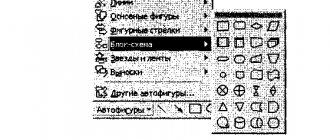Is it necessary to draw up an accounting policy?
Currently, no regulatory act directly states that individual entrepreneurs must have an accounting policy. The procedure for determining the tax base is strictly regulated:
- under the simplified tax system – Ch. 26. 2 NK;
- for OSNO – Ch. NK;
- UTII - Ch. 26.3 NK;
- in the patent system, one must be guided by the provisions of Chapter. 26.5 of the Tax Code and regional legislation.
But the fact that the document must also be drawn up by entrepreneurs indirectly confirms clause 2 of Art. 11 of the Tax Code - it states that in the accounting policy the taxpayer determines the methods of accounting for income and expenses. And taxpayers also include individual entrepreneurs (in accordance with Art. Tax Code).
In addition, there are a number of points on which it is necessary to secure the chosen accounting option - to justify the inclusion of costs in the tax base, in order to protect the entrepreneur in the event of a tax audit.
What should be included in the organizational section of the accounting policy?
Organizational and administrative information in the NUP may include:
- an indication of the person responsible for organizing and maintaining tax records - such a person can assign these functions to himself or another authorized person;
- clarify the accounting system used - its form (electronic or paper), data entry format, procedure for storing and protecting information, etc.;
- other important aspects for organizing tax accounting (the procedure for issuing money for reporting, etc.).
If an individual entrepreneur does not have employees, this chapter of the NUP will be minimal in scope, since there is no one to organize, and the description of any regulations in this case for individual entrepreneurs on the simplified tax system (income) does not make much sense.
The materials posted on our website will help you draw up the organizational chapter of the NUP:
- “Review of free accounting programs for the simplified tax system”;
- “The procedure for separate accounting under the simplified tax system and UTII”.
Composition of the accounting policy of individual entrepreneurs for 2020
What to include in the accounting policy depends not only on the system used, but also on the purposes for which it will be used - for accounting, tax or management accounting. In any case, first of all, the document must reflect:
- taxation;
- the accounting forms used are independently developed or unified (for accounting, additionally, the applicable chart of accounts), maintained in electronic form, whether on paper, with or without software.
It is advisable to indicate the person responsible for maintaining records (the individual entrepreneur himself or another official, for example, an accountant).
There is no exact list of issues to be reflected in the accounting policy - an individual entrepreneur can independently outline the range of necessary information that will help to thoroughly understand the methods of calculations.
Results
An individual entrepreneur using the simplified tax system (income) is not required to draw up an accounting policy.
But if he decides to do this, then in it he can provide for important accounting, reporting and organizational nuances: the procedure for reporting and paying the simplified tax system, insurance premiums, and other tax obligations, designate the persons responsible for maintaining records, describe the procedure for storing documents and electronic information etc. You can find more complete information on the topic in ConsultantPlus. Full and free access to the system for 2 days.
Accounting policy of individual entrepreneurs on UTII
The example we offer below can be taken as a basis. If an entrepreneur uses only UTII, it is enough for him to indicate in the document how the accounting of taxable objects is kept, and how the paid contributions (at the time of payment) and sick leave benefits are taken into account in the calculation.
If there is a combination of regimes, then in the accounting policies of individual entrepreneurs on UTII and the simplified tax system (or OSNO) it is necessary to explain in detail not only how income and expenses are taken into account, but also how they are distributed among different taxation systems.
Tax accounting
With simplified taxation of individual entrepreneurs, the accounting policy should reflect:
- Tax object and tax rate.
- The composition of income, the method of accounting for it and how it is maintained (manual records or electronic generation of KUDiR).
- Possible reduction of the base from which the tax is paid by the amount of insurance premiums.
- The method of adjusting amounts in the present period for errors made in past reports.
- Responsible persons.
Accounting policy of individual entrepreneurs on the simplified tax system
Income accounting
There is no need to fully indicate the formation of the revenue part of the tax base in accordance with the Tax Code. Accounting policy of individual entrepreneur simplified tax system “income”, sample may include:
- what is classified as income from main activities and what is classified as other (when separately accounting for different regimes, for example, simplified tax system and UTII, a procedure for their distribution is needed);
- accounting for advances;
- other necessary points (for example, the procedure for adjusting the tax base - correcting errors, returning advances and erroneous payments, etc.).
For the accounting policy of individual entrepreneurs on the simplified tax system “income”, which provides for tax accounting, it is enough to additionally write off clauses on the write-off of expenses that reduce the base (the method of their distribution is especially important if there is separate accounting) - contributions, sick leave at the expense of the employer and accounting for sales tax. Since expenses under the simplified tax system of 6% do not affect tax obligations, it makes sense to enter further points into the document only when maintaining full-fledged accounting records.
Therefore, we will further take the individual entrepreneur’s accounting policy “income minus expenses” as a basis.
Fixed Asset Accounting
The accounting policy includes information about the accounting of fixed assets. What they indicate:
- the procedure for determining the initial cost (the amount of actual acquisition costs);
- which objects are accounted for as inventories, and which are included in fixed assets;
- whether the service life of the previous owner is taken into account, or the depreciation rate is determined by the classifier;
- the procedure for writing off the cost, including in case of partial payment of property.
Indicate the method of calculating depreciation (linear or non-linear), as well as whether special coefficients or depreciation bonuses are applied.
This section is also important in the accounting policy of individual entrepreneurs on OSNO, since depreciation of fixed assets reduces tax liabilities.
Materials accounting
Describe the procedure for determining the cost of raw materials and materials. Are transportation and procurement costs included in the cost (or are they taken into account separately). How to write off:
- at average cost;
- at the cost of each unit;
- at the cost of the first acquisition in time (FIFO).
You can specify which documents serve as the basis for write-off.
Goods accounting
The document indicates how the cost of goods is formed and whether transport costs are taken into account. How to write off:
- at average cost;
- by unit cost;
- using the FIFO method.
You can describe in detail the methodology for determining the amount of expenses for goods included in the tax base.
Expenses
In the section you can indicate how other costs are formed (for example, for fuel and lubricants). When accounting separately, it is necessary to describe exactly how the taxpayer distributes expenses (including staff salaries, contributions, sick leave) between different regimes.
Losses
Since, with a simplified tax system of 15%, losses from previous years can reduce the tax base, you can prescribe the procedure for their accounting (maintaining a separate register, if there is one). Next, indicate how they are taken into account when obtaining annual profit. The accounting policy of individual entrepreneurs on the simplified tax system, a sample for “income minus expenses,” can be downloaded below.
What should be indicated in the accounting policy
There is no standard accounting policy; everyone makes it taking into account the characteristics of their business. There is only a general list of provisions that must be written down in it. What basic information needs to be reflected?
General provisions for all individual entrepreneurs:
- What tax regime do you use;
- Who has the right to sign documents;
- How cash documents are processed, if it is carried out (it is advisable to indicate the cashier’s full name), or a clause stating that cash documents are not processed;
- The size of the cash limit at the cash register, the procedure for calculating it, or a clause stating that you do not apply the cash balance limit at the cash register;
- How money is issued (cash from the cash register / to a bank card), the procedure for issuing;
- Availability of the right to use preferential (reduced) rates on insurance premiums, their amount.
Additionally for individual entrepreneurs using simplified language:
- What tax object do you use (“income” or “income - expenses”);
- What method of valuing materials do you use (unit cost, average cost, FIFO method);
Additionally for individual entrepreneurs on UTII:
- How do you take into account and distribute physical indicators between types of business;
- How do you take into account and distribute expenses between types of business;
Additionally for individual entrepreneurs when combining simplified taxation system and UTII:
- How are the total expenses distributed?
- How are insurance premiums distributed for yourself?
- How are employee contributions distributed?
- How are contributions distributed if individual entrepreneurs are employed only in business on the simplified tax system, or only in business on UTII.
In addition, the UE must include:
- a list of used primary documents for which there are unified forms and make a link to this;
- a list of primary items for which there are no standard forms and you made them yourself - the forms must be included in the accounting policy;
- similarly, include ledger forms that you yourself have developed for use in accounting.
Accounting policy of individual entrepreneurs on OSNO
Entrepreneurs in the general regime should describe in as much detail as possible what costs are included in reducing the tax base. The accounting policy may provide for the option of applying a professional deduction (in what cases is it applied and how is it calculated).
The formed individual entrepreneur accounting policy for 2020 must be approved by order of the entrepreneur no later than December 2020. If the document has already been drawn up in previous years and no changes are expected in it, then its validity can be extended for the next period without issuing a new one. When changing the taxation regime, changing the accounting policy is mandatory.
The accounting policies of individual entrepreneurs can be found below.
What is impossible to do without when drawing up an accounting policy?
When registering NUP for individual entrepreneurs on the simplified tax system (income), the main section will be devoted to the algorithm for forming the taxable base for the simplified tax system and the features associated with the procedure for recognizing income.
At the same time, it is not at all necessary to copy verbatim from the Tax Code of the Russian Federation into this paragraph of the NUP the list of income to be taken into account when calculating tax. It is important to distinguish between sales income and non-operating income, as well as indicate non-accounted income based on the actual activities of the individual entrepreneur.
In the NUP, you can detail the nuances of income accounting in the context of the following analytics:
- by type of activity used;
- by methods of receiving income (receiving money at the cash desk, to a current account, income in kind, when paying with bills, etc.).
The NUP may also reflect:
- formulas for calculating advance payments and the amount of the final payment for the simplified tax system;
What expenses can be used to reduce the tax or advance payment under the simplified tax system with the object “income” are described in detail in ConsultantPlus. Get trial online access for free and go to the Ready-made solution.
- reporting procedure;
- tax payment deadlines;
- other nuances (features of tax calculation and registration of KUDiR when receiving money as a refund of erroneously transferred amounts, etc.).
How to fill out the book form for accounting income and expenses under the simplified tax system with the object “income”? Detailed recommendations from ConsultantPlus experts are available in the Ready Solution. Get a free trial of K+ and follow the instructions.
Individual entrepreneur Ivanov I.I.
ORDER No. 3
on approval of accounting policies for tax purposes in the city of Moscow 12/30/2016 I ORDER:
- Approve the accounting policy for tax purposes for 2017 in accordance with the appendix.
- I entrust myself with control over the execution of this order.
Individual entrepreneur I.I. Ivanov Appendix 1 to order dated December 30, 2016 No. 3
Accounting policies for tax purposes
1. Keep tax records in person.
2. Apply the object of taxation in the form of the difference between income and expenses. Reason: Article 346.14 of the Tax Code of the Russian Federation.
3. Maintain an automated book of income and expenses using the standard version of “1C: Entrepreneur 8”. Reason: Article 346.24 of the Tax Code of the Russian Federation, paragraph 1.4 of the Procedure approved by Order of the Ministry of Finance of Russia dated October 22, 2012 No. 135n, subparagraph 1 of Part 2 of Article 6 of the Law of December 6, 2011 No. 402-FZ.
4. Entries in the book of income and expenses should be made on the basis of primary documents for each business transaction. Reason: clause 1.1 of the Procedure approved by order of the Ministry of Finance of Russia dated October 22, 2012 No. 135n, part 2 of Article 9 of the Law dated December 6, 2011 No. 402-FZ. Accounting for depreciable property
5. The initial cost of a fixed asset is determined as the amount of actual costs for its acquisition, construction, production in the manner established by the legislation on accounting. Reason: subparagraph 1 of part 2 of article 6 of the Law of December 6, 2011 No. 402-FZ, subparagraph 3 of paragraph 3 of article 346.16 of the Tax Code of the Russian Federation.
6. Subject to payment, the initial cost of the fixed asset, as well as the costs of its additional equipment (reconstruction, modernization and technical re-equipment) are reflected in the book of income and expenses in equal shares, starting from the quarter in which the paid fixed asset was put into operation until the end of the year. When calculating the share, the cost of partially paid fixed assets is taken into account in the amount of partial payment.
7. The share of the cost of a fixed asset (intangible asset) acquired during the period of application of the simplified tax system, subject to recognition in the reporting period, is determined by dividing the initial cost by the number of quarters remaining until the end of the year, including the quarter in which all conditions for writing off the cost of the object as expenses are met .
8. If a partially paid fixed asset is put into operation, the share of its cost recognized in the current and remaining quarters until the end of the year is determined by dividing the amount of partial payment for the quarter by the number of quarters remaining until the end of the year, including the quarter in which the payment was made. partial payment for the commissioned facility. Reason: subparagraph 3 of paragraph 3 of Article 346.16, subparagraph 4 of paragraph 2 of Article 346.17 of the Tax Code of the Russian Federation. Accounting for inventory items
9. Material costs include the purchase price of materials, costs of commissions to intermediaries, import customs duties and fees, transportation costs, as well as costs of information and consulting services related to the purchase of materials. Amounts of value added tax paid to suppliers when purchasing material inventories are reflected in the income and expense book as a separate line at the time materials are recognized as costs. Reason: subparagraph 5 of paragraph 1, paragraph 2 of paragraph 2 of Article 346.16, paragraph 2 of Article 254, subparagraph 8 of paragraph 1 of Article 346.16 of the Tax Code of the Russian Federation.
10. Material costs are included in costs as they are paid. In this case, material costs are adjusted to the cost of materials not used in commercial activities. The adjustment is reflected as a negative entry in the income and expenses ledger as of the last date of the quarter. To determine the amount of the adjustment, the method of valuing materials at the cost of a unit of inventory is used. Reason: subparagraph 1 of paragraph 2 of Article 346.17, paragraph 2 of Article 346.16, paragraph 1 of Article 252, paragraph 8 of Article 254 of the Tax Code of the Russian Federation.
11. Expenses for fuels and lubricants within the limits of standards are taken into account as part of material expenses. The date of recognition of expenses is the date of payment for fuel and lubricants. Reason: subparagraph 5 of paragraph 1 of Article 346.16, paragraph 2 of Article 346.17 of the Tax Code of the Russian Federation.
12. Standards for recognizing expenses for fuel and lubricants as expenses are calculated as trips are made based on waybills. An entry is made in the book of income and expenses in the amount of amounts not exceeding the standard. Reason: paragraph 2 of Article 346.17 of the Tax Code of the Russian Federation, letter of the Federal Tax Service of Russia for Moscow dated January 30, 2009 No. 19-12/007413.
13. The cost of goods purchased for further sale is determined based on the price of their purchase under the contract (reduced by the amount of VAT presented by the supplier of the goods). Reason: subparagraphs 8 and 23 of paragraph 1 of Article 346.16 of the Tax Code of the Russian Federation.
14. The cost of goods purchased for resale is included in costs as the goods are sold. All goods sold are valued using the average cost method. Reason: subclause 23 of clause 1 of article 346.16, subclause 2 of clause 2 of article 346.17 of the Tax Code of the Russian Federation.
15. Amounts of value added tax presented on goods purchased for resale are included in costs as the goods are sold. In this case, VAT amounts are reflected in the book of income and expenses as a separate line. Reason: subparagraphs 8 and 23 of paragraph 1 of Article 346.16, subparagraph 2 of paragraph 2 of Article 346.17 of the Tax Code of the Russian Federation, letter of the Ministry of Finance of Russia dated December 2, 2009 No. 03-11-06/2/256.
16. Costs associated with the purchase of goods, including costs of servicing and transporting goods, are included in costs as actual payment is made. Reason: subparagraph 23 of paragraph 1 of Article 346.16, paragraph 6 of subparagraph 2 of paragraph 2 of Article 346.17 of the Tax Code of the Russian Federation, letter of the Ministry of Finance of Russia dated September 8, 2011 No. 03-11-06/2/124.
17. An entry in the book of income and expenses regarding the recognition of materials as expenses is made on the basis of a payment order (or other document confirming payment for materials or expenses associated with their acquisition).
An entry in the book of income and expenses regarding the recognition of goods as expenses is made on the basis of an invoice for the release of goods to the buyer. Reason: subparagraph 1 of paragraph 2 of Article 346.17 of the Tax Code of the Russian Federation, letter of the Ministry of Finance of Russia dated January 18, 2010 No. 03-11-11/03, paragraph 1.1 of the Procedure approved by order of the Ministry of Finance of Russia dated October 22, 2012 No. 135n. Cost accounting
18. The costs of selling goods purchased for resale include costs of storing and transporting goods to the buyer, as well as costs of servicing goods, including costs of renting and maintaining retail buildings and premises, advertising costs and remuneration of intermediaries selling goods.
Expenses for the sale of goods are taken into account as expenses after their actual payment. Reason: subparagraph 23 of paragraph 1 of Article 346.16, paragraph 6 of subparagraph 2 of paragraph 2 of Article 346.17 of the Tax Code of the Russian Federation, letter of the Ministry of Finance of Russia dated April 15, 2010 No. 03-11-06/2/59.
19. The amount of expenses (except for expenses for fuel and lubricants) taken into account when calculating the single tax within the limits of the standards is calculated quarterly on an accrual basis based on the paid expenses of the reporting (tax) period. An entry on the adjustment of standardized costs is made in the book of income and expenses after the corresponding calculation at the end of the reporting period. Reason: paragraph 2 of article 346.16, paragraph 5 of article 346.18, article 346.19 of the Tax Code of the Russian Federation.
20. Interest on borrowed funds is included in expenses within the refinancing rate of the Central Bank of the Russian Federation, increased by 1.8 times, for ruble obligations and a coefficient of 0.8 for debt obligations in foreign currency. Reason: paragraph 2 of Article 346.16, paragraph 1 of Article 269 of the Tax Code of the Russian Federation. Accounting for losses
21. An individual entrepreneur reduces the tax base for the current year by the entire amount of loss for the previous 10 tax periods. In this case, the loss is not transferred to that part of the current year’s profit for which the amount of the single tax does not exceed the amount of the minimum tax. Reason: paragraph 7 of Article 346.18 of the Tax Code of the Russian Federation, letter of the Federal Tax Service of Russia dated July 14, 2010 No. ШС-37-3/6701.
22. An individual entrepreneur includes in expenses the difference between the amount of the minimum tax paid and the amount of tax calculated in the general manner. This includes increasing the amount of losses carried forward to the future. Reason: paragraph 4 of paragraph 6 of Article 346.18 of the Tax Code of the Russian Federation.
In today’s article I want to talk a little about the accounting policies of individual entrepreneurs. Many not only don’t make it up, but they don’t even know what it is.
In fact, an accounting policy (AP) is a document, even a set of provisions, describing the process of accounting for business transactions. That is, all the methods, methods and rules for accounting for income/expenses, preparing primary records, maintaining registers, drawing up accounting and tax reporting, and calculating indicators.









